Boys and Gun Love: A Thinking Mother’s Dilemma
My sons know how I feel about gunplay, yet the more I forbid it, the more their curiosity draws them toward these forbidden objects -- the toy version of the lethal instruments at the center of our national debate.My sons know how I feel about gunplay, yet the more I forbid it, the more their curiosity draws them toward these forbidden objects—the toy version of the lethal instruments at the center of our national debate.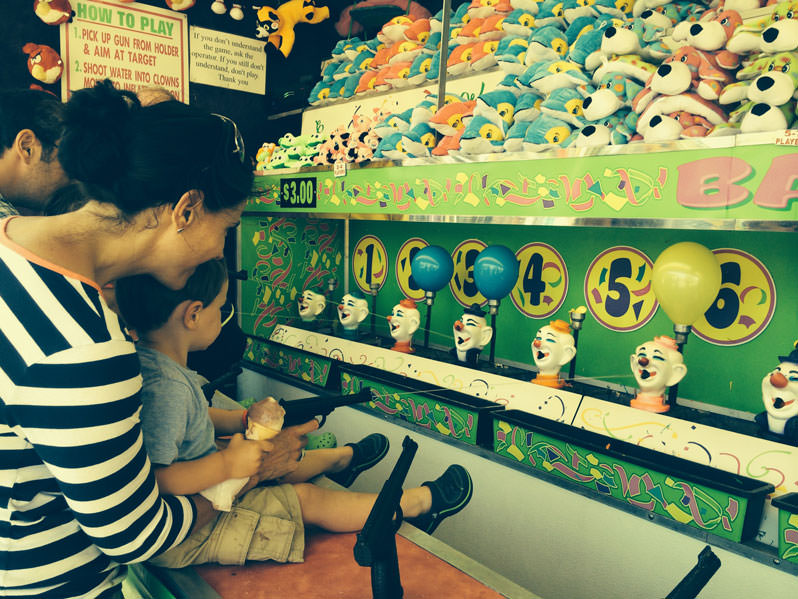 Photo by Pamela Alma Weymouth
Photo by Pamela Alma Weymouth
By Pamela Alma Weymouth
My 7-year-old twin sons were gawking at the black plastic guns in the shooting range at the Mill Valley Carnival. It’s a game as old as American carnivals themselves. A row of toy guns shoot water into the lipsticked mouths of clowns. The carny was barking, “One shot for $3! Two for five!” I watched my little boys take in the big boys, the guns, the wall of toys, and I felt my maternal power dwindle in the face of such a compelling lure. My sons know how I feel about gunplay, yet the more I forbid it, the more their curiosity draws them toward these forbidden objects — the toy version of the lethal instruments at the center of our national debate.
A friend leaned over and whispered, “Did you hear about Santa Barbara?” He said it softly enough to shelter my sons from the news of another semiautomatic assault weapons massacre. The facts were similar to other such sprees: A disturbed and bullied young man purchased three semiautomatic assault weapons (legally) and 400 rounds of ammunition, and killed six college students and severely injured 13 others in the normally quiet beach town of Isla Vista, Calif. The 22-year-old shooter then took his own life. This time those killed were young people on the threshold of their future: a painter who liked to ballroom dance; a computer-science major who loved to work with children; a financial wizard who excelled at sports; a shy computer science major who was always helping others; an English major with an airline ticket to London; a computer engineer who never bragged about acing his SATs.
And Thursday, in the course of writing this article, yet another shooting occurred, this time at Seattle Pacific University and leaving one dead and three college students injured.
As of late January this year, there had been an average of one school shooting every other day in the U.S., despite pleas from parents for stronger gun control laws. In 2013, there were 28 school shootings. At least 17 Americans have died daily from gunshots since Newtown –although numbers may be higher due to unreported suicides. Since Jan. 1, there have been 4,594 deaths and 8,091 injuries caused by gun violence, 512 of them involving children (numbers as of Friday). To put it in an international context, children in the U.S. between the ages of 5 and 14 are at least 13 times more likely to be killed by guns than in any other industrialized nation. Too many towns to name, too many tragedies forgotten already by everyone except those whose sons, daughters, granddaughters, grandsons, sisters and brothers were taken.
My boys’ intrigue with guns was immediate and early — leaving me grappling with the question: Does banning gunplay foster peace-loving kids or does it force our sons (although some girls engage in war play, I’m talking about boys predominantly, because research has shown that boys are more often drawn to war play than girls) to find less healthy releases for their aggressive impulses?
My belief that only boys raised in pro-military or violent homes would gravitate toward gunplay was overturned by my sons’ fascination with guns and all things war related. Even though I chose to ban TV and video games from my home (in favor of books, audiobooks and old-fashioned outdoor play), to my surprise, guns and superhero stories found their way into my sons’ consciousness. They learned about rifles from the hunters who shoot Babar’s mother and the rifle-carrying safari hunters who capture Horton in Dr. Seuss’ classic “Horton Hatches the Egg.” Even Christopher Robin owns a popgun.
In preschool, my sons learned about superheroes — and how to beat my system. “I’m Spider-Man!” shouted Quinn, pointing two fingers at me menacingly. “I’m shooting you with my web!” Banned from gunplay in his San Francisco preschool, my son and his peers found a way around it.
In response to the unchecked gun violence in our country, panicked educators across the U.S. have been cracking down on pretend gunplay. But tellingly, the children’s draw toward war play tends only to resurface. Some schools have gone so far as to institute “zero-tolerance” policies. Five-year-old Madison of the Mount Carmel Area School District in Pennsylvania was suspended for “making a terrorist threat” with a Hello Kitty soap-bubble gun; a group of 12-year-olds at an Edmonds, Wash., school were suspended for shooting Nerf guns, even though they had been brought in for an experiment on probability; 11-year-old Caden of Chicago was “interrogated” by school authorities after turning in a plastic gun during a security guard pat-down; an 8-year-old Maryland boy was castigated for biting a Pop-Tart into the shape of a gun (he claimed it was a mountain).The men in my life suggest my concerns about gunplay are as unreasonable as such school crackdowns. I caught our 67-year-old godfather teaching my sons how to turn blades of sea grass into guns, a game he had played as a boy. My sons’ father argued that he and his brother had spent hours tossing fake bombs over the neighbors’ bushes. Now, he is a public school teacher and his brother is an anti-war Democrat, a social worker and a Buddhist.
Veteran kindergarten and pre-K teacher Lisa Stapp of Edna Maguire Elementary School in Mill Valley, Calif., said, “Boys are always making weapons out of cubes,” but she believes it is the adult’s job to explore it rather than squash it. “If you explore it more, you start to draw out a scenario and eventually the violence gets neutralized into an engaging play of some sort,” whereas if you ban it “we end up shaming children,” which causes problems down the road. “Every time we say stop, we curtail all that brain growth,” she noted.
Psychotherapist Lele Diamond, a specialist in post-traumatic stress disorder and childhood development, agreed that “aggressive play is a child’s laboratory.” It is “really helpful — both to channel it and temper it.” As long as the parent or educator sets limits that allow for all children to be safe, she suggests that aggressive play is not only healthy, but a necessary tool for children’s social-emotional development. Kids know the difference between “pretend” aggression and real aggression. We adults should not conflate the two.
So if gunplay is healthy, perhaps even necessary, then what about toy guns? Nancy Carlsson-Paige and Diane E. Levin, educators who have studied the impact of war play, maintain that when it comes to gunplay or war toys, the best kinds of toys are those crafted by the kids themselves. Legos, blocks, sticks, cardboard boxes, toys that can transform from guns to magic wands to towers, for example. This way the child is in charge of the play, rather than the toy being in charge of the child. Carlsson-Paige and Levin explain that when TV was deregulated in the 1980s, children lost all of the protections that had heretofore kept them from being commercially exploited. This, in turn, led to a change in the way children played. “The emphasis in play shifted from ‘What can I do with this toy?’ to ‘Can I get another one?’ ” Carlsson-Paige said. Toy-driven play does not foster the kind of imaginative problem solving skills that help children figure out right from wrong, good from bad, and their place in the group.
Yet, is gunplay OK for all kids? Diamond suggests that for kids who grow up in neighborhoods plagued by violence, parents have a right, even a duty, to toe a different line. “It’s a life and death issue — it’s worth a tooth and nail fight” because the kind of violent play some of these boys engage in is not creative play, but “role practicing,” she argued. It’s part of their real world. And if “moms come down hard” against gunplay in these situations, Diamond contended, “it’s because they need to.”
My introspective son Aidan asked me to play at the carnival gun range, so I said yes. I tried to remember it’s just a game. I have photographs of myself posing as a 20-something at a carnival, pretending to look tough with a long black toy rifle in hand, a big grin on my face. This time, when I aimed, the water shot into the clown’s mouth making an orange, red, blue and green balloon inflate until POP! I thought of my grandfather whose access to a 28-gauge shotgun made it that much easier to take his own life at the age of 48, a trauma that took him from his young wife, four children and his future grandchildren, myself included. A trauma that continues to reverberate through our family generations later.
Aidan’s green balloon exploded first and he won a small blue whale. But Aidan wanted the biggest stuffed animal, the one the man said we couldn’t have. So instead we were down $10 and my son wasn’t satisfied. Had he learned something? I think not, because although we return year after year to the carnival, the cheap toys end up in the trash and my sons forget, seduced once more by the barker, who may as well be shouting, “Be a man! Be a man! Shoot a gun and you’ll be strong, tough, invincible!”
Psychologists Daniel Kindlon and Michael Thompson write in their book “Raising Cain,” “The media serves up as role models Neanderthal professional wrestlers, hockey ‘goons,’ ready at the slightest provocation to drop their sticks and pummel an opponent; multi-millionaire professional athletes in trouble with the law, demanding ‘respect’ from fans and the press; and angry, drug-using, misogynist rock-stars. … These are not visions of manhood that celebrate emotional introspection or empathy.” And yet these educators suggest that the only way to raise healthier boys, ones able to master their aggressive impulses, is to “give our boys an emotional vocabulary and the encouragement to use it” so that “they will unclench their hearts.” A few months ago, my sons met their 96-year-old great-grandfather, Vice Adm. Ralph Weymouth, a World War II naval aviator and decorated war “hero.” They asked him if he had killed people, dropped bombs, handled real weapons, and he said yes. Yet, my grandfather is also one of the founding members of Veterans for Peace. When asked what he thought about toy guns, he told my boys what he did when my father (his oldest son) asked for a toy popgun from the store. “I took him to the garage and we carved one out of wood,” he said. As they worked together, my grandfather explained the workings of real guns to my father and warned about the harm they can do. They talked, they made art, they played, and my father grew up to be an architect.
When I hear that once more Congress has failed to enact any significant gun control measures, I wonder whether this is not the real reason schools and educators and parents have cracked down so hard on gunplay — because it’s easier to tell our kids what to do than it is to tell our politicians. Should we not be directing all this adult rage toward the real source of change, the NRA and our Congress? Ironically, the Florida legislature found the time and energy to protect the safety of play for children in their state, passing the infamous Pop-Tart bill, but they were not able to get behind the concept of banning real weapons from spaces in which children eat and play. This is not a Republican issue or a Democratic one; this is a parental issue — all of us deserve for our kids to be safe. Let’s let the children play and ask the grown-ups to get to work giving a timeout to the real bullies on the playground.
Pamela Alma Weymouth’s essays have appeared in The Huffington Post, Inhabitat.com, Inhabitots.com and the anthology “Mamas Write.” She teaches writing in San Francisco, where she lives with her twin sons, three hens and one Taiwanese puppy.
Your support matters…Independent journalism is under threat and overshadowed by heavily funded mainstream media.
You can help level the playing field. Become a member.
Your tax-deductible contribution keeps us digging beneath the headlines to give you thought-provoking, investigative reporting and analysis that unearths what's really happening- without compromise.
Give today to support our courageous, independent journalists.
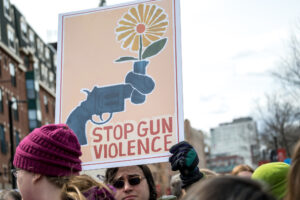
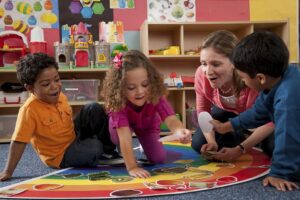
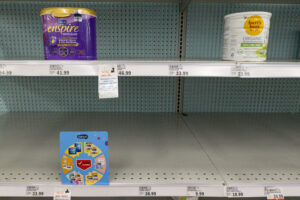
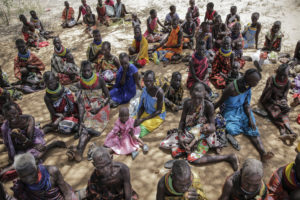

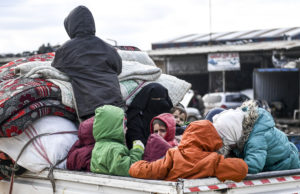
You need to be a supporter to comment.
There are currently no responses to this article.
Be the first to respond.